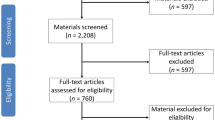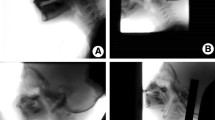Abstract
Videofluoroscopy has become an increasingly important armament in the investigation and assessment of swallowing disorders. However, very little work has been published on the radiation dose used in such examinations and currently there is no national diagnostic reference level in the United Kingdom. Videofluoroscopy in our hospital is performed predominantly by one radiologist (IZM) in a single fluoroscopy room. We recorded the screening times of 230 patients over a 45-month period. Screening time ranged from 18 to 564 s (median = 171 s) associated with a median dose-area product of 1.4 Gy cm2. This is below the third quartile level of 2.7 Gy cm2 for all such examinations performed across the northern England. The effective dose associated with a typical videofluoroscopy dose-area product is 0.2 mSv. Videofluoroscopy is the most appropriate instrumental examination for assessing oropharyngeal swallow biomechanics and intervention strategies. This data set is based on the largest number of videofluoroscopy swallow studies published to date. Our results show that videofluoroscopy can be performed using minimal radiation doses.
Similar content being viewed by others
Explore related subjects
Discover the latest articles, news and stories from top researchers in related subjects.Avoid common mistakes on your manuscript.
Oropharyngeal dysphagia is a relatively common condition that is evaluated clinically by a specialist speech-language pathologist (SLP). Where appropriate, further instrumental procedures such as endoscopic swallow evaluations (e.g., FEES), videofluoroscopy, and barium swallow will be used [1]. Videofluoroscopy is considered to be the gold standard in diagnostic imaging of the swallow process [2]. Videofluoroscopy involves the use of X-rays and there is increasing concern about radiation doses in all diagnostic and interventional procedures. Recent legislation [3] in the United Kingdom requires both a knowledge of the radiation dose given during any medical procedure and an adherence to the “as low as reasonably achievable” (ALARA) principle for all exposures. Radiation dose is dependent on the operator, the screening room used, and patient compliance [4]. We have evaluated the patient radiation dose imparted by the same operator with 15 years’ experience in videofluoroscopy comprising one session a week with an average weekly case load of three patients. The same screening machine was used and the patients presented with various pathologies. For comparison, doses received during barium swallow procedures carried out by the same operator in the same screening room were also evaluated.
Materials and Methods
Participants
Over a 45-month period between June 2001 and March 2005 the videofluoroscopic swallow studies of 230 patients were evaluated. The studies were all of adult patients (69 female, 161 male; age range = 17–98 yr, median = 67 yr; height = 147–196 cm, median = 170 cm; weight = 38–102 kg, median = 67 kg). The patients’ underlying problems included complicated head and neck cancer after radiotherapy/surgery, stroke, post-traumatic brain damage, neurologic impairment, and a small number of patients with no definite etiology. To give figures as representative as possible, very few studies were excluded; postlaryngectomy patients undergoing speech valve evaluation or therapeutic Botox injections, and patients undergoing a barium swallow and videofluoroscopy in the same sitting were excluded.
Videofluoroscopy Technique
All examinations were performed using a Siemens Sireskop 5-45 digital fluororadiography system (Siemens Medical Systems, Erlangen, Germany). Patients were screened either while standing or sitting on a Mangar Porter chair with a radiotranslucent backrest (Mangar International, Presteigne, Wales) depending on their mobility. The patients were always screened in the lateral position and in the anteroposterior (AP) position when appropriate, with a mean kVp of 77 (median = 70 kVp, range = 50–120 kVp). The examination was recorded on videotape, and spot films were not routinely taken unless unexpected pathology such as a stricture was identified. Collimation was routinely performed to exclude the eyes and brain from the primary beam. A specialist SLP and a technician radiologist were routinely present in addition to the consultant radiologist. The eating trials covered a range of controlled consistencies and bolus volumes: from thin liquids to muffin saturated with barium and from a teaspoon to drinking from a cup.
Dose Assessment
The fluoroscopy room was fitted with a Dose-Area Product (DAP) meter, which was calibrated using established methods based on the National Standards [5] and connected to a laptop computer for collection of data as part of a regional patient dosimetry program [6]. Screening times and DAPs were then recorded routinely for all the patients examined in the room, along with their height and weight. The DAP data were adjusted to what would have been obtained for standard-sized patients using an established technique [7]. The recorded DAP values included contributions from both fluoroscopy and spot films when these were taken.
Effective dose was calculated from DAP for each patient using conversion factors published by the National Radiological Protection Board (NRPB) [8]. The conversion factors for lateral throat projection were used at the appropriate kV in each case. This projection includes the thyroid, upper esophagus, and topmost lung in the irradiated area, and corresponds most closely to irradiation during videofluoroscopy. No conversion factors are available for AP throat projection but, because of the size and organ location in the throat region, these are unlikely to differ greatly from those for the lateral projection, and the contribution of AP irradiation to the total in any case is small.
Results
Screening time depended on the complexity of the swallowing assessment and patient compliance. A wide range of screening times was documented with a median time of 171 s (range = 18–564 s) associated with a median DAP of 1.4 Gy cm2. There is currently no national UK reference level, but this value is below the third quartile level of 2.7 Gy cm2 for all such examinations performed across northern England in 2004 [6]. To the best of our knowledge, there is also no known diagnostic reference for videofluoroscopy in the United States. The effective dose for the procedure ranged from 0.01 to 1.1 mSv (median = 0.2 mSv). For the 85% of examinations for which no image acquisition shots were taken, the mean DAP/screening time was 0.5 Gy cm2/min, corresponding to an estimated average videofluoroscopy effective dose of 0.06 mSv/min.
For comparison, the barium swallow national reference is 11 Gy cm2 [9], and over a 44-month period 41 patients underwent a barium swallow examination by radiologist IZM (19 female, 22 male, age range = 37–92 yr, median = 70 yr). The comparative data are shown in Table 1. Tube potential ranged from 60 to 90 kVp, and the number of images taken ranged from 0 to 33 (median= 9).
Discussion
Exposure to ionizing radiation is detrimental to health and can broadly be divided into having deterministic and nondeterministic (stochastic) effects. Deterministic effects occur above a certain radiation dose and are rarely seen in diagnostic departments because this threshold level is reached only during some lengthy interventional procedures. Nondeterministic effects differ from deterministic effects in that the biological effect is an all-or-none result, not everyone irradiated receives the effect, the probability that the effect will occur but not its severity increases with dose, and there is no threshold dose level [10]. Nondeterministic effects occur because of mutations at a cellular level potentially leading to hereditary effects or cancer induction. Because of this theoretical risk of nondeterministic effects, particularly because so many patients have multiple imaging, radiologists are legally required to minimize the radiation dose [3].
In the case of screening procedures such as barium examinations, operator experience may have a great bearing on the screening time [4]; thus, the results of only one operator have been included in this study. It should also be appreciated that everyone living in the UK is exposed to background radiation ranging from 1.5 to 7.5 mSv per year depending on location, so the typical videofluoroscopy effective dose of 0.2 mSv is extremely small comparatively. This equates to around ten chest X-rays and is considerably less than the effective dose from a plain lumbar spine radiograph.
The risk of fatal malignancy is 5%/Sv for a population 18–64 years old [11]. This gives an associated risk of a radiation-induced fatal cancer for an average videofluoroscopy examination of 1 in 100,000 and considerably less for patients over 69 years old. For the pediatric population the risk is double, and the radiosensitivity of the thyroid is known to be particularly high [12]. For this reason, those services dealing with children should be even more cautious in limiting the screening time to the absolute minimum.
Wright et al. [4] recorded the dose received by 23 patients undergoing videofluoroscopy as a mean effective dose of 0.4 mSv and a mean DAP of 4 Gy cm2. Crawley et al. [13] recorded an effective dose of 0.85 mSv and median DAP of 3.5 Gy cm2 in a series of 21 patients. Our results show a median DAP of 1.4 Gy cm2, considerably less than previous studies and less than the average regional dose of 2.6 Gy cm2 in the northeast area of the country that was calculated for 2004. Our results are also considerably less than the median DAP recorded of 2.5 Gy cm2 for barium swallows performed by the same operator in the same room.
Videofluoroscopy is the most appropriate instrumental examination for assessing oropharyngeal swallow biomechanics and intervention strategies. Knowledge of anatomy and physiology is essential in the management of a patient with an impaired swallow. Our results show that videofluoroscopy can be performed using minimal radiation doses.
References
Leslie P, Carding P, Wilson J: Investigation and management of chronic dysphagia. BMJ 326:433–436, 2003
Logemann JA: Evaluation and Treatment of Swallowing Disorders, 2nd ed. Austin, TX: ProEd, 1997
HMSO (Her Majesty’s Stationary Office): Statutory Instrument 2000, No. 1059: The Ionising Radiation (Medical Exposure Regulations), London, UK
Wright RE, Boyd CS, Workman A: Radiation doses to patients during pharyngeal videofluoroscopy. Dysphagia 13:113–115, 1998
Faulkner K, Busch H, Cooney P, Malone J, Marshall N, Rawlings D: An intercomparison of Dose-Area Product meters. Radiat Prot Dosimetry 43:131–134, 1992
Regional Medical Physics Department, Newcastle General Hospital: Annual Dose-Area Product Report, 2004
Chapple C-L, Broadhead D, Faulkner K: A phantom based method for deriving typical patient doses from measurements of dose-area product on populations of patients. Br J Radiol 68:1083–1086, 1995
Hart D, Jones D, Wall B: Estimation of effective dose in diagnostic radiology from entrance surface dose and Dose-Area Product measurements. National Radiological Protection Board Report 262, HMSO, London, UK, 1994
Joint Working Party (IPEM BIR RCR NRPB CR): Report 88: Guidance on the Establishment and Use of Diagnostic Reference Levels for Medical X-Ray Examinations. Institute of Physics and Engineering on Medicine Report 88, York, UK, 2004
Beck TJ, Gayler BW: Image quality and radiation levels in videofluoroscopy for swallowing studies: a review. Dysphagia 5:118–128, 1990
Cox R, MacGibbon B, Muirhead C, Stather J, Edwards A, Haylock R: Diagnostic Medical Exposures: Advice on Exposure to Ionising Radiation During Pregnancy Estimates of Late Radiation Risks to the UK Population. National Radiological Protection Board Report 4, HMSO, London, UK, 1994
ICRP (2005) Recommendations of the International Commission on Radiological Protection (Draft). Available at http://www.icrp.org
Crawley MT, Savage P, Oakley F: Patient and operator dose during fluoroscopic examination of swallow mechanism. Br J Radiol 77:654–656, 2004
Author information
Authors and Affiliations
Corresponding author
Additional information
This study was performed at Freeman Hospital, Newcastle upon Tyne, UK.
Rights and permissions
About this article
Cite this article
Zammit-Maempel, I., Chapple, CL. & Leslie, P. Radiation Dose in Videofluoroscopic Swallow Studies. Dysphagia 22, 13–15 (2007). https://doi.org/10.1007/s00455-006-9031-x
Received:
Accepted:
Published:
Issue Date:
DOI: https://doi.org/10.1007/s00455-006-9031-x




